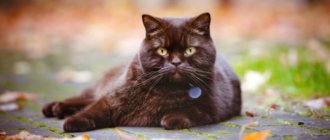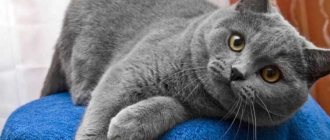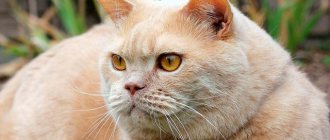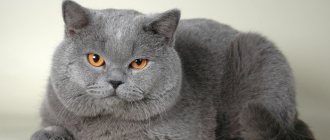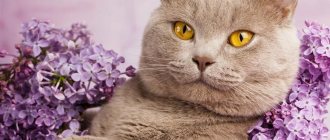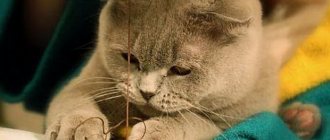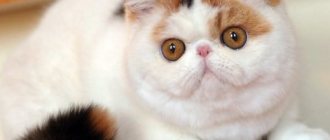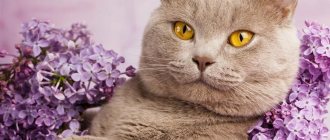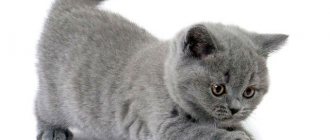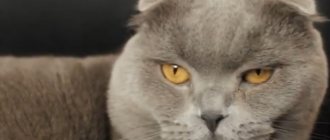| Country of origin | Great Britain |
| Dimensions | weight – 5-9 kg, height – 30-45 cm, body length – 55-65 cm. |
| Wool | short |
| Lifespan | 14-20 years old, average 12.5 years |
“Impressive”, “plump and round”, “teddy bears” - these are the names the British cat receives from its admirers. The British Shorthair cat breed is very popular in the UK and is one of the ten most popular in the world. The Cheshire cat with his famous smile described by L. Carroll in “Alice in Wonderland” is none other than the British Shorthair.
Origin story
It is believed that cats, which later became British, came to the islands of the same name back in the 2nd century BC. along with the Roman legionnaires. The breed developed under conditions of island isolation. And targeted breeding began only in the 19th century.
In 1871, the British Shorthair was officially presented at an exhibition in London, and in 1889 it received recognition as the British Blue.
While other colors were also considered breeds in Europe, the Americans remained adamant for a long time. The blue British woman was considered true. And only when a British black cat won the exhibition in 1968, other types of colors were recognized.
By the beginning of the 20th century. fashion has changed: they began to love Siamese and Persian cats more. The British population has declined sharply. After World War II, interest in the British cat breed increased, but there were only a few breeders. Therefore, the British were crossed with Persians, Russian Blues, and Carthusian cats. The result was new colors, a more powerful body and a rounder appearance.
From connections with the Persians, the British adopted one feature - the gene for long hair. It took several decades to get rid of it. But the kittens continued to be born with long hair. As a result, 2 types of British cats appeared: a shorthair and a second with fluffy hair, which transformed into a separate breed - the British Longhair or Highlander.
British: cats with history
The best British cats took part in improving the breed. However, these cats also owe their modern appearance to their Persian representatives. From them they received a characteristic slightly flat muzzle.
World wars had a negative impact on the development and improvement of the British cat breed. The population decreased, so breeders crossed the remaining Britons with representatives of similar breeds.
This is how the blood of Burmese, Scottish cats, Russian Blue breeds and Chartreuse got into the genetics of the British.
The formation of the breed was finally completed by 1980. This year, British cats received the title of champions, and felinological organizations confirmed the official recognition of the individuals.
The British became the first English breed to gain worldwide recognition.
Description of the breed
The British Shorthair is a large animal. A strong body, full cheeks, and a round head make the cat very impressive. Everything about the Briton is round: his head, eyes, paws and even the tip of his tail. The whisker pads stand out well, making the face smile.
The peculiarity of British cats is their late development. Animals acquire features that fully meet the standard only by 3-5 years.
What a British cat looks like that meets the standard is presented in the table:
| Become | Breed characteristics |
| Head | Big round. It has smooth outlines from any angle of view. Short, thick neck. A strong chin, which with the pads of the mustache fits into the correct oval. The nose is wide along its entire length, short. There is a small depression on the bridge of the nose. The cheeks are large and appear drooping. The ears are set wide apart, medium in size, with rounded tips. The ears are slightly tilted forward (approximately 35 degrees). The eyes are large and wide open. Color: copper, orange, gold. British color point cats can have blue eyes, while golden and silver cats can have green eyes. |
| Body | Powerful with a wide chest, squat. A wide bone indicates breed qualities. |
| Legs | Medium length or short, strong. The paws are round. |
| Tail | Thick with a rounded tip, medium length. |
| Wool | Very dense, plush, short. Does not adhere to the body. The undercoat is well developed. The ideal texture is when, when stroking against growth, the fur does not move behind the hand. |
The head is given the greatest attention when assessing breed qualities.
Flaws:
- long nose, hump;
- the shape of the head is not round, but more like a box;
- narrow ears, falling apart to the sides, too large (hare ears), turned back;
- slanted eyes;
- insufficiently full cheeks;
- undershot;
- fox face due to the elongated nose, slanted eyes and weak chin.
Accepted Standards
Clean cats of the British breed should have the correct head shape with an expanded skull. The muzzle is also round, and adults have slightly full cheeks, which make them “smiling.”
The pet's nose is short, straight and wide. If you look at the purr from the side, there will be a slight depression where the nose meets the forehead.
The ears are set low but set wide apart. At the same time, the eyes are quite large and open, with a golden tint. The standard mentions that owners of the point color have blue eyes. The presence of a bright green and even lavender hue cannot be ruled out.
But some breeders consider dull color or the presence of a rim near the pupil to be a defect.
Other breed deficiencies may include:
- Excessive secretion of mucous membranes.
- “Exoticness” of the muzzle. If there is a pronounced transition from the forehead to a hump, the muzzle loses its aesthetic appeal. In addition to the deformation of the nose, the proportionality of the eyes and cheekbones deteriorates.
- The shape of the muzzle is often identical to that of barn cats. This is emphasized by a flat forehead, large brow ridges and a long nose.
Over the years of living on the British island, the animals developed a strong immune system and became the owners of a strong, muscular body of medium or large size. Pets are characterized by a wide torso and a massive back, as well as strong but short legs. The length of the tail is considered short, but with a thickened diameter.
All existing subspecies of the British breed are distinguished by pronounced sexual demorphism. Externally, cats are much smaller than cats, especially when it comes to adults. Animals are able to quickly gain weight, while their maturation occurs at a slow pace. The kitten grows up to four years old, and the last stage of development of appearance is completed upon reaching the age of 5 years. Over a five-year period of time, a pet gains about 5-8 kg, and a cat weighs 4-6 kg. The average lifespan of British cats reaches 15 years.
The coat has different lengths, which are determined by the breed line. According to the standard, any characteristics of wool are allowed, with the exception of length. The following color types are not yet permitted:
- White.
- Color point.
As for short-haired pets, their coat is 2.4 mm long.
Those with long hair are characterized by an aristocratic character. Mixing them with other cat breeds is strictly prohibited.
If there is a monochromatic color, a balanced coloring of each hair is provided, so any third-party shades are excluded. The breed standard does not allow haze, shimmer or shade.
There are about 30 color options for British breed cats. And animals with black, blue, cream, red, lilac and white fur have special decorative value.
The best two-tone colors are blue-silver, tabby, ticked and merle.
Today, cats with the “Whiskas” coloring are in particular demand. They took part in the filming of the famous advertisement. The official name of the color is “mackerel”. The characteristic combination of shades is due to three wide stripes in the back area.
Due to the “plushness” of the coat, owners of some colors do not look graceful enough. These include individuals with chocolate fur (cinnamon).
British Fold
There is an expression "loose-eared British", but this species does not exist. There are 2 breeds - the British Shorthair and the Scottish Fold. A separate variety of the latter is identified - the Scottish straight-eared (Scottish Straight), which is also called the pointed-eared.
All of these breeds are closely related and were once bred to each other. But in 2004, the WCF introduced a ban on mating Scottish and British cats.
Features of character and behavior
Habits and character are the factors that make British cats popular.
Main character traits:
- balanced people do not like to show unnecessary emotions;
- unperturbed;
- peace-loving;
- devotees.
Cats have a truly English character. They have a sense of tact and self-esteem. They are not intrusive and will not bother the owner. At the same time, they love affection.
The British are not curious and well-mannered. This is inherent in them at the genetic level. But they don’t like to be controlled, picked up, or burdened with something.
The characteristics of the breed include tolerance. Because of this, the British woman gets along well with children. However, the cat does not like to be squeezed and dragged. He treats other animals calmly, even dogs.
They are distinguished by their developed intelligence and practically do not need education. Even small kittens that have just begun to walk quickly learn to use the toilet. However, adult animals are difficult to train.
Kittens are very active and playful. By the age of 4-5 years, an adult cat becomes slower. He prefers to watch what is happening from a convenient place and not get in the way.
In adulthood, when activity decreases, you need to monitor your pet’s weight.
Nevertheless, the hunting instinct is highly developed. Despite its massive size, the British cat is agile and fast. The reaction speed can be especially noticeable when hungry. The awkward heavyweight becomes quick and graceful in a second to get to the bowl.
Characteristics of British behavior
The British Shorthair cat must be raised for up to one year. At this time, you can instill in him some character traits. After a year of life, it will be too late to change anything. And if a cat behaves badly, this is a consequence of poor upbringing in childhood.
This noble breed means that its representatives devote a lot of time to their appearance. Licking is a favorite pastime of these cats.
Despite the fact that the British breed is quite positive regarding its behavior and character, there are still features that cause a lot of discontent among British owners:
- Scattering things and objects. Even in childhood, kittens need to be weaned off this “cute” behavior. Indeed, at first it looks charming both in the photo and in reality. However, in the future, flower pots, vases, etc. will be used. To do this, you need to treat your “favorite” things with special compounds.
- Playing with the hands and feet of its owner. It is better to offer your baby a scratching post or special toys.
- The British are incredibly curious. Therefore, they can easily be found in packages, new things, and hard-to-reach places. You can often come across photos like this that only cause tenderness.
The British breed is one of the most popular in the world today.
Such cats attract attention not only with their cute appearance, but also with their unpretentious character.
Care and maintenance
Thanks to their thick fur coat, the British always have a neat appearance. However, they require regular care.
British cats need to be taught to groom from infancy.
| Procedure | Recommendations | Periodicity |
| Rub your eyes | The eyes are wiped with a cotton pad moistened with boiled, lukewarm water. The problem of leaking eyes is typical for newborn kittens and babies under 1 year old. | Daily |
| Examination and cleaning of ears | Ear cleaning is carried out only superficially as it gets dirty. | Inspection daily |
| Teeth cleaning | The British breed is prone to dental and gum disease. Therefore, it is necessary to brush your teeth with a special paste and brush. | 1 time per week |
| Combing | It is better to use an antistatic comb with a medium distance between teeth. First comb in the direction of hair growth, then in the opposite direction. Slickers often damage the plushness of the coat, so their use is not recommended. During shedding, you can remove dead fur with a latex glove. | 1-2 times a week. During molting period daily. |
| Nail trimming | No more than 1.5-2 mm is cut off, only the white part, so as not to damage the blood vessels. | Once every 1-1.5 weeks |
| Bathing | Special shampoos are used. It is permissible to use dry shampoo to clean the coat once every 2-3 weeks and the coat will be perfect. | Once every 2-3 months |
In addition, the British Shorthair is perhaps the only smooth-haired cat that likes to be brushed against the grain.
An interesting fact about British cats is that they have the largest number of hair follicles per square meter. cm and means the thickest wool of all breeds.
Feeding
The British are prone to excess weight. This must be taken into account when creating a menu. With a natural diet, the basis of the diet is lean meat (beef, chicken), offal, cereals (rice, buckwheat), vegetables, dairy products, cottage cheese. When feeding homemade food, mineral supplements and vitamins are required.
Properly balancing a natural menu is difficult. Therefore, preference is given to premium and super premium dry food. These foods already contain all the necessary vitamins.
When a kitten is taken to a new home, at first you cannot radically change the brand of food. This can lead to intestinal upset. The transition to a new diet should be gradual. Over the course of several days, mix the new food into the old one, gradually increasing its amount.
The kitten is fed 4-5 times a day or food is left freely available. By 1 year, the number of feedings is reduced to 2 times a day.
The animal should always have water. Preferably soft, cleaned. Hard, chlorinated tap water can serve as a provoking factor for the occurrence of urolithiasis.
What to look for when choosing a pet?
Ears – growing straight and widely set. The tail is short and rounded at the tip, the paws are of medium length, strong and rounded.
The baby must be healthy, active, clean and well-groomed. There should be no foreign discharge from the eyes, nose or ears. Kittens' fur is usually smooth and velvety, soft to the touch, without pellets, tangles or bald spots. Make sure the kitten doesn't itch.
It is appropriate to ask for the kitten's pedigree and research the parents.
Choose a well-fed and strong kitten, but be prepared for the fact that the cost of just such a baby may be higher.
British cat health
Overall, the British Shorthair is a healthy breed compared to other cats. However, there is a tendency to certain diseases:
- Hypertrophic cardiomyopathy. Heart problems are more common in males than females.
- Blood clotting disorder.
- Gum diseases.
- Obesity.
Annual vaccination and proper nutrition are the main preventive measures against the occurrence of cat diseases.
At 8-12 weeks, kittens are vaccinated with a complex vaccine against panleukopenia, calicivirus, rhinotracheitis, rabies, and chlamydia. After 21 days, the vaccination is repeated. Subsequent vaccinations take place annually.
Health and vaccinations
British cats are the owners of good health and good immunity. This is the merit of breeders and geneticists. The most common diseases include obesity and increased lacrimation. By carefully monitoring your pet's condition and choosing the right diet for it, you can avoid these ailments.
If you don’t take care of your cat, he can get sick with any diseases that are typical for cats of all breeds.
Correct and timely vaccination is the key to a cat’s health. Before the first vaccination, you should undergo anthelmintic therapy. The cat is given medications that destroy helminths and parasites of internal organs.
At the age of three months, the British are given a rabies vaccination; it consists of three vaccinations, each of which is given three weeks after the previous one. Then it is repeated annually. Vaccination against infectious diseases is mandatory.
How to choose the right British kitten
Purebred British kittens are not sold in the transition or on the market. You can buy a purebred British breed kitten only from a certified nursery.
There is no point in watching a British boy before 1.5 months. At this age it is impossible to assess his appearance.
Many people believe that purebred blue British kittens should have orange eyes. This is a common myth because all babies are born with blue eyes. Color changes at 3-4 months. It is at this age that it is recommended to buy a kitten. The breeder has already given the first vaccinations, toilet training and independent feeding.
Based on the photo, you can reserve a kitten on the nursery’s website, but visiting it before purchasing is required.
Signs of a good nursery:
- Doesn't smell like urine, clean.
- There are many toys, play complexes, scratching posts.
- There is a nursery certificate and pedigree. There should be no Persians or Scots in the pedigree.
What to look for when choosing and what British Shorthair kittens should be like:
- playful, moderately well-fed;
- well-groomed and healthy;
- calm, not afraid to make contact.
The owner of the cattery will tell you basic information about the British Shorthair cat: principles of feeding, rules of care. And he will always be in touch to help if necessary.
How much do British kittens cost?
In many ways, how much a British cat costs depends on the cattery, the class of the kitten, and the color.
British kittens are divided into classes by the breeder:
- Pet (pet) is a pet, not for breeding and not for exhibitions. The price starts from $100, but largely depends on the color. So lilac, blue, whiskey costs from 100-150, gold, chinchilla - from $500.
- Breeding – kittens for breeding cost on average from $300 to $500.
- Show – kittens with a high quality rating. The price depends on the color and on average varies from $500 to $2000. The most expensive because it is rare - gold British. Its cost is more than $2000.
Colors of British cats
The following colors are typical for the British:
- Blue. Gray wool without light hairs. Skin is blue.
- A monochromatic color is considered if the skin, undercoat and coat itself are the same color, and there is not a single spot. Lilac is a combination of pink and blue. The nose and paws are purple. Eyes - copper or orange.
- Chocolate is a rich brown color.
- Black is a jet black color. Sometimes kittens are born with black fur, but it fades over time. This adds complexity to breeding black pets.
- White - pinkish skin and cool coat tone. Yellow spots are not acceptable.
- Cinnamon is a cinnamon color, similar to light brown.
- Fawn is a combination of creme brulee and pink.
- Marble/classic - dark spots or stripes on light sides. The eyes are copper with dark eyeliner.
- Bicolor - predominance of white at least 1/3, but not more than 1/2;
For the long-haired variety of the breed, all colors are acceptable except white and color point.
Advantages and disadvantages
The British cat breed has many advantages and it is difficult to find its shortcomings.
Pros:
- Balanced, calm temperament.
- Does not require constant attention.
- They rarely meow.
- Easy care.
Disadvantages of the breed:
- Late development. Pedigree traits are finally formed only by 3-5 years of age.
- I don’t like it when a person causes “inconvenience”.
British cat: character, psychology
The British cat has a calm and docile character. As a kitten, he is active and playful. With age he becomes lazy and clumsy. Therefore, it is recommended to force the cat to run, jump and play in order to prevent obesity from developing.
You can install a cat house and climbing devices in your home to encourage your cat to exert effort before getting into a secluded area.
The British treat all family members well, do not offend children and patiently tolerate their activity. But in relation to themselves, they do not accept excesses. If a Brit gets tired of his master's attention, he retires to a secluded place and rests. At this time, it is better not to disturb the cat, otherwise he will fight back by releasing his claws.
British cats tolerate being around other pets well, but prefer to remain the leader of the pack. For example, if there is another cat living at home, most likely he will be subordinated to the British.
British cats are intelligent and well-mannered by nature, but they are difficult to train. Genetics will not allow a Briton to scratch furniture and make a toilet anywhere.

